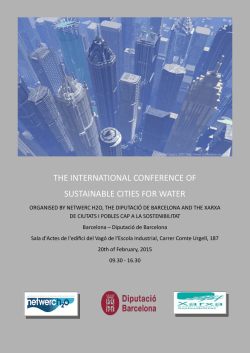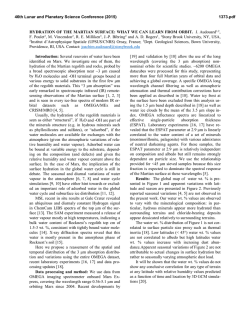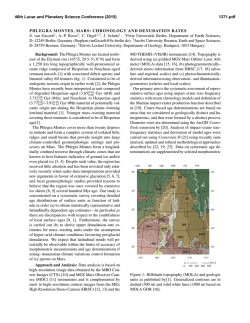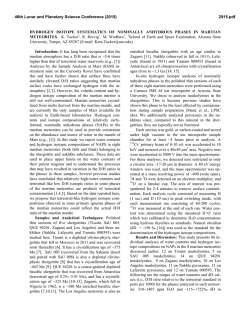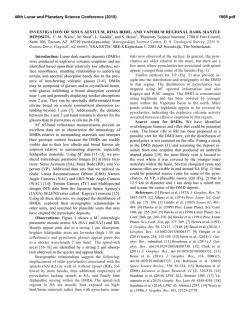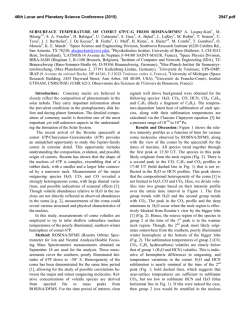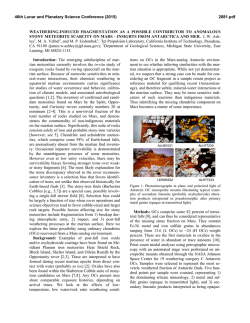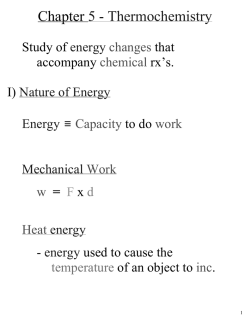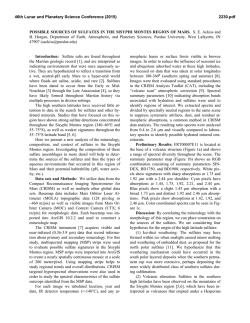
1175
46th Lunar and Planetary Science Conference (2015) 1175.pdf LATITUDINAL VARIATION IN THE ASSOCIATION OF H2O WITH SULFUR IN MARTIAN SOIL. Suniti Karunatillake1, James J. Wray2, Olivier Gasnault3,4, Scott M. McLennan5, A. Deanne Rogers5, Steven W. Squyres6, William V. Boynton7, J. R. Skok1, Nicole E. Button1, Lujendra Ojha2 1Geology and Geophysics, Louisiana State University, USA ([email protected]) Note equal contributor, James J. Wray; 2Earth and Atmospheric Sciences, Georgia Institute of Technology, USA; 3Université de Toulouse, Toulouse, France; 4CNRS, France; 5Department of Geosciences, Stony Brook University, USA; 6Department of Astronomy, Cornell University, USA; 7Department of Planetary Sciences, University of Arizona, USA. Introduction: The significance of H2O to any putative extant or extinct biosphere, as well as its potential role in the chemical and physical evolution of the Martian crust both present and past [1,2] make factors affecting the distribution of H2O on Mars singularly important. S variation plays an equally important role as a control on inferred fluid pH, alteration environments, and water activity [3]; atmospheric-regolith S cycles and processes may dominate over epochal time scales [4,5]; analogous environments on Earth suggest atmospheric controls on S-cycles [6]. The variability of hydration due to thermodynamic stability [7,8], due to diversity of sulfate minerals as determined remotely [9], and due to diversity observed in situ [10] may obscure any association between H2O and S. Additionally, ice tables detected within ~ 1 m depth at latitudes as low as 45° [11] suggest a complex interplay among scattered ice bodies at depth and various water-bearing material at shallower levels including clay, zeolite, and silica [12 – 14]. The Mars Odyssey Gamma Ray Spectrometer (GRS) is sensitive to such depth variation as it samples the surface to several decimeter depths. Relative to the tens of microns sensitivity of visible, near infrared, and thermal infrared (VN/TIR) instruments, this may reveal compositional differences with the surface. Such possibility also arises from in situ observations at Gusev Crater where Paso Robles type soil, rich in Fe-sulfates, sometimes underlies “typical” Martian basaltic soil [10]. In the context of such complexities, our recent work [15] suggests a compelling association of H2O and S, consistent with hydrous Fe3+ sulfate distribution at global scales, especially in the Southern hemisphere. Regolith at grain sizes smaller than gravel, constituting the bulk of the Martian subsurface at regional scales, may be a primary repository of chemical alteration, mechanical alteration, and bio-signatures. The GRS, with hundreds of km lateral resolution and compositional sensitivity to decimeter depth, provides unique insight into this component of the regolith, which we call soil. In this work, we assess the latitudinal variation in hydration state, as represented by the H2O : S molar ratio. The latter may contribute to meaningful differences in climate conditions that control the atmosphere-sur- face interface and resultant soil composition. The regional scope of our work is assisted in particular by the GRS’s intrinsic spatial resolution of roughly 440 km [16], complementing the local chemistry [13] of VN/TIR remote sensing missions. Data and methods: We use elemental mass fraction data derived from GRS γ photon spectra as discussed by Boynton et al. [17]. These data are limited to between roughly ±60° latitude since [17] accurate mass fractions are difficult to calculate within the polar regions with the exception of H2O. While the relatively low intensity of characteristic peaks for S makes the mass fraction map difficult to generate, spectra accumulated during science operations enabled the first such midlatitudinal map to be created [18]. Nevertheless, substantial smoothing necessary to achieve sufficient numerical precision causes spatial autocorrelation [19] and limits the spatial resolution of the S mass fraction map. Therefore, we utilized 10° × 10° bins for the S mass fraction, w(S), dataset. Accordingly, we rebinned w(H2O) from its original 5° × 5° resolution to 10° × 10°. We map the global hydration state distribution by first computing the moles of H2O, n(H2O), and of S, n(S), in 100 g of soil at each 10° × 10° bin. This takes the form w(H2O) × 0.0555 employing standard atomic mass values [20]. Similarly, w(S) × 0.0312 yields the S moles. The molar ratio is computed subsequently, with corresponding uncertainty propagated as 𝑛(𝐻2 𝑂) 𝑛(𝑆) 𝜎𝑚 {𝑤(𝑆)} 2 √[ 𝑤(𝑆) ] +[ 𝜎𝑚 {𝑤(𝐻2 𝑂)} 2 𝑤(𝐻2 𝑂) ] , where σm denotes the standard error of each variable. Ratios in the radical employ mass fractions, since the molar conversion factor for mass fraction and its standard error cancels. The molar ratio and corresponding uncertainty maps underpin our analyses. We developed a comparative mineral library on the basis of peer-reviewed literature on remote sensing and in situ observations [10,21]; thermodynamic [22] and climatic models [4]; hydration-dehydration experiments that simulate Martian conditions [23]; and meteoritic observations [24]. This places candidate minerals in several overlapping categories: bulk soil observed in situ; outcrop and bedrock sensed remotely or in situ; and thermodynamic feasibility. The nature of γ photon spectra reflecting elemental composition at regional 46th Lunar and Planetary Science Conference (2015) scale makes the judicious selection of minerals essential; a merely exhaustive list of all terrestrial and laboratory minerals would undermine effective modeling. Accordingly, we consider 27 candidates with 13 distinct H2O : S molar ratios to compare with the distribution of GRS-derived values. Results and discussion: Despite substantial overlap in possible hydration states across the mineral groups, Mg-sulfates are generally not hydrated in the 2.5 to 4 range with the exception of starkeyite at 4 [22]; even amorphous meta-stable forms of Mg-sulfates may not exceed a hydration state of 3 [25] and are thermodynamically more likely to be hydrated at 1 – 2 [22]. Figure 1. Hydration state plotted against latitude to identify latitudinal variations in average hydration. Blue error bars signify one standard error and the black dot indicates the average, both accounting for heteroscedasticity [26]. Mid-point of each 10̊ -wide latitudinal bands is shown on the x-axis. Intriguingly, Figure 1 shows a sustained trend of increasing hydration state from less than 3.5 (e.g., between ferricopiapite and kornelite) to values exceeding 3.5 (e.g., starkeyite) within the map bounds in the Northern hemisphere. Decreasing mean S concentrations accompany this trend. The proportional decrease in average S molar content (moles per 100 g of regolith), of ~16% relative to the equatorial band’s 0.074 value (equivalent to mass fraction .074×32.065 = 2.4%), compares favorably with the ~15% proportional increase in the hydration state from ~3.3 at the equator. This suggests less variability in H2O concentration northward than S, reinforcing the hemispheric-scale decoupling between them in the North [15]. H2O abundances may decouple from S in the North due to a confluence of decreasing depth to ground ice stability, H2O accumulation in pore spaces of fine particle mantles presumably thickening northward, H2O adsorption on fine particles, and specific surface area [27,28]. Additional potential contributors include the proportion of amorphous phases that may adsorb H2O 1175.pdf [29], weakening chemical association with S. Consequently, sulfate may exert only a minor influence on the latitudinal variations in hydration states in the Northern hemisphere. Unlike the North, hydration state generally decreases Southward from the Equator (Figure 1). With the exception of the 50° - 60° latitudinal band, the hydration state decreases from the equatorial band to about 2.8 as S molar content decreases to ~0.06. The similar decrease of both by about 15% reinforces the compelling possibility of H2O bound primarily in sulfates in the Southern hemisphere [15] producing a spatially associated variation in both. Higher hydration state in the 50° - 60° South band relative to much of the Southern hemisphere may reflect a decoupling of S and H2O in the polar regime of Mars, perhaps analogous to the broader trend at play in the Northern hemisphere. References:[1] Bishop, J. L. et al. Planet. Space Sci. 86, 130 – 149 (2013); [2] Michalski, J. R. et al. Nat. Geosci. 6, 133–138 (2013); [3] Tosca, N. J. et al. Science 320, 1204–1207 (2008); [4] Halevy, I. et al. Science 318, 1903–7 (2007); [5] Halevy, I. & Schrag, D. P. Geophys. Res. Lett. 36, L23201 (2009); [6] Peng, Y. et al. in 44th LPSC 2427 (2013); [7] Feldman, W. C. et al. J. Geophys. Res. 110, E11009 (2005); [8] Steiger, M. et al. Geochim. Cosmochim. Acta 75, 3600–3626 (2011); [9] Murchie, S. L. et al. J. Geophys. Res. 114, E00D06 (2009); [10] Yen, A. S. et al. J. Geophys. Res. 113, E06S10 (2008); [11] Byrne, S. et al. Science 325, 1674–6 (2009); [12] Jouglet, D. et al. J. Geophys. Res. 112, E08S06 (2007); [13] Bishop, J. L. et al. J. Geophys. Res. 114, E00D09 (2009); [14] Wray, J. J. et al. Geology 37, 1043–1046 (2009); [15] Karunatillake, S. et al. Geophys. Res. Lett. 41, 7987–7996 (2014); [16] Karunatillake, S. et al. J. Geophys. Res. 112, E08S90 (2007); [17] Boynton, W. V. et al. J. Geophys. Res. 112, 1–15 (2007) [18] King, P. L. & McLennan, S. M. Elements 6, 107–112 (2010); [19] Karunatillake, S. et al. Earth. Moon. Planets 108, 253 – 273 (2012); [20] Wieser, M. E. Pure Appl. Chem. 78, 2051–2066 (2006); [21] Lane, M. D. et al. Am. Mineral. (2014) doi:10.2138/am.2014.4762; [22] Steiger, M. et al. Geochim. Cosmochim. Acta 75, 3600–3626 (2011); [23] Xu, W. & Parise, J. B. Am. Mineral. 97, 378–383 (2012); [24] Righter, K. et al. Earth Planet. Sci. Lett. 288, 235–243 (2009); [25] Wang, A. et al. J. Geophys. Res. 114, E04010 (2009); [26] Karunatillake, S. et al. Earth. Moon. Planets 108, 253 – 273 (2012); [27] Janchen, J. & Brettschneider, T. in 42nd LPSC 2, 1369 (2011); [28] Beck, P., Pommerol, A., Schmitt, B. & Brissaud, O. J. Geophys. Res. 115, E10011 (2010); [29] Meslin, P.-Y. et al. Science 341, 1238670–1238670 (2013).
© Copyright 2025
